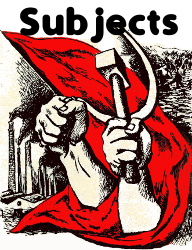




|
Love in
Sandy Lane
(1962) It had no street sign, but everyone knew it as Sandy Lane. It was short—no more than two hundred yards long—and started at the charming villa ‘Mariame Ba’, which blocked the far end, and came out on to the main street which ran right through the district. It had got its name from a great number of things. Opposite the entrance to Sandy Lane the villa ‘Mariame Ba’ stood proud and spruce, painted yellow and blue. Amid the collection of decrepit old shacks, it had a manorial aspect; its greyish windows disclosed three rooms, each covered from floor to ceiling with photographs, some in glass frames. After timis, the sunset prayer, El Hadj Mar usually climbed on to the terrace overlooking the street. Below him was spread the jumble of rooftops, some flat, some pointed, the straw huts and the shacks. The inhabitants of Sandy Lane might have seemed very proud of ‘their villa’. But deep down, each of them nursed a feeling of animosity towards the old employee of the late colonial administration, who from his lofty perch openly pried on their every action. First in the lane, going down on the right, was Pourogne’s shack, which leaned outwards and was shored up by three beams firmly embedded in the sand; the bottom planks were crumbling away and had been patched up with pieces of galvanized iron, and the red paint had faded in the sun. Then came the public fountain which had been condemned. (It was whispered in the district that this was due to the inhabitants’ obstinacy towards government policy; for everyone except El Hadj Mar, so it was said, had voted ‘No’ in the 1958 referendum (Whether or not to become independent of France). So because of their rebellious character they were obliged to go elsewhere for water.) Next came Yaye Hady’s compound, which was fenced round with bamboo wattle; in order to be considered a member of the Sandy Lane community, Yaye Hady had blocked up the old entrance giving on to the main street and had made a new one on the Sandy Lane side. Adjacent to him was the Niangs’ M’bar. The Niang family still carried on the goldsmith’s craft handed down to them by their forbears, and by their love of this delicate work had greatly contributed to the fame of the lane. Their female clientele came from all parts of the town. The eldest Niang, a big fellow with a large behind, had a jolly face and the cavernous eyes of the old, without eyebrows or lashes; he sat outside his workshop and gave interminable salamalecs to everyone coming out into the lane, except to El Hadj Mar. Then there was Salif’s carpenter’s shop; he was a wiry, very dark man, most amusing when so inclined, but a tireless singer. The people of Sandy Lane became worried if he was silent. That is why, when Salif’s voice was no longer heard, it was said that ‘the Sandy Lane people’ were in a bad way. And last of all on the right-hand side, adjoining the villa ‘Mariame Ba’, was the big shack housing the family of old Maissa. He was a very devout man who never went out without his beads. On the left-hand side of the lane was the mother-house of Granny Aita; the brick base was crumbling away and was riddled with holes into which the hens and ducks vanished. Three tall, pliable filos served as a refuge for the catiocatios. As soon as it was dusk, these weaver-birds filled the air with their ‘catio-catio’ calls, hence their name. Their textile-nests looked like dangling black balls in the gathering darkness. Next came Mavdo’s patch; he was the charcoal merchant, and a black dune as high as a hut spilled over from the patch. Then came the Youth Club, a hut with ‘Palais de l’ONU’ (UN Palace) chalked above the door. A few dozen young men met there, most of them out of work through no fault of their own. Through the door could be seen piles of old magazines, emblems of many nations and pictures of Heads of State and leaders of political parties from all over the world. When the young men were tired of discussions they drowned their passion for politics in Moorish tea. Last of all, at an angle to the villa ‘Mariame Ba’, was an unfinished building intended long ago for a policeman. When evening came, children went and relieved themselves among the heaps of bricks still lying around, as though it was the most natural thing in the world. Such was the outward appearance, the material aspect, of Sandy Lane. It was nothing to write home about. But the people who lived there harbored a different kind of wealth, which had brought renown to this part of the town. Once a week all the housewives got together to clean the lane. Early in the morning they all lined up in front of their doorways on both sides of the lane; they would bend down, little brush in hand, as though about to begin a dance. The two lines advanced and met in the middle, where, as if working to music, they divided into little groups and swept towards the main street like rippling waves. Then they dug a hole and buried all the rubbish. The lane was made of very fine sand which did not crunch underfoot. It was because of this rather exaggerated cleanliness that the inhabitants proudly allowed people from neighboring streets to organize drum sessions in their lane, and the faithful there celebrated the birth of the Prophet. It was a peaceful little lane, and the only one in the town to have such diverse and yet united characters living in it. However, a very common incident, too common at the present time, put an end to this state of affairs ... The people of Sandy Lane were not scandalmongers, but—and this was the cause of the trouble—neither did they confide in one another: In Sandy Lane there lived a girl, Kine, who was El Hadj Mar’s eldest daughter by his second wife. Her beauty was talked about all over the town. Her physical charms were a favorite subject for the songs of the youths who frequented the ‘Palais de l’ONU’. When she returned from market, her calabash on her slightly tilted head, her graceful neck curved a little and her smooth, velvety shoulders showing above the wide neck of her muslin boubou, her walk so stately, the people of Sandy Lane - especially the men - turned and teased her; and she smiled back, showing her regular little white teeth. Nothing was a secret in Sandy Lane; but no one ever talked of it, that was all. Everyone knew that Kine’s heart beat only for Yoro, the old charcoal-merchant’s son. Yoro was a shy young man, but he also played the kora. Sometimes he left the shelter of the ‘Palais de l’ONU’ and plucked up his courage to go and strum his kora beneath the windows of the villa ‘Mariame Ba’. When he and Kine happened to come face to face, or when their eyes met, there was a pleasant rush of blood, a warm, sweet rush of blood, in both of them; it rose from their toes and ran through their veins, giving them a warm sensation, warmer than anything else. The people of Sandy Lane were simple or naive and they liked these two youngsters; and as this love reminded them of their own, they seemed to bless it by a conspiratorial silence. They thought quite simply that if two people loved one another, nothing could be strong enough to stand in their way. Secretly—though the Sandy Lane folk were not very talkative—they were preparing to celebrate the wedding in their own fashion. All of them, men and women, said to Kine whenever she passed by, ‘How’s Yoro?’ And to Yoro they said, ‘How’s Kine?’ When Yoro came home from work at midday and at six o’clock, as soon as he reached Pourogne’s shop he would look towards the villa. He scanned all the windows; and Kine, knowing it was the time for him to return, would be standing at one of the windows. And all Sandy Lane having discovered the young couple’s secret, their way of greeting and communicating with each other, as soon as Yoro entered the lane a swarm of eyes instantly turned in the direction of the villa. They were very discreet, though, the lane’s inhabitants. They never said very much. In the end the two turtle-doves gave up this deaf-and-dumb language; and in the evenings, after the last prayer, when everybody had come to sit outside and the night was draped in its starry robe, Yoro would sit in a fold of darkness and strum his kora while Kine, sitting with her parents in front of the villa, would let her thoughts run on. Sandy Lane was well known. It was often mentioned in the songs of griots, for El Hadj Mar, a generous man, frequently invited story-tellers into his house. The tale of the mute love of Kine and Yoro went from mouth to mouth. Yet neither of them had gone beyond stealing shy glances, blinking, or sounding the quivering notes of the kora. One day people saw mature men who occupied prominent positions in the country arriving in Sandy Lane. Among them was more than one Minister, several Chief Secretaries and other personalities. They all went to El Hadj Mar’s house, where they spent the whole day feasting and drinking to excess. And they returned several times. Every week holes were dug in front of the villa and soon whole sheep could be seen roasting on spits over a wood fire. There were always official cars parked at the entrance to Sandy Lane; big, luxurious cars. The regulars of the ‘Palais de l’ONU’ felt frustrated; they supported Yoro. The other people, experienced observers as they were, muttered indignantly. Every day now, at midday and at six, their eyes remained firmly fixed on the ground; and the strumming of the kora was no longer heard in the evening. A month went by, a funereal silence settled on the lane—and Yoro had disappeared. Three months later, Kine was seen no more. (I was told that after the disappearance of the lovers, two trees were planted - a male and a female.) But since these happenings, Sandy Lane has ceased to be the pride of the district; the rubbish piles up, and the women throw their slops outside the villa ‘Mariame Ba’. These people who formerly never uttered an oath have become foul-mouthed. The young men leave to live elsewhere. No longer are religious chants heard in the lane, and the drums throb no more . . . Sandy Lane has become the saddest place in the world. And as I walked around Dakar I wondered if the whole town was not under this curse. |